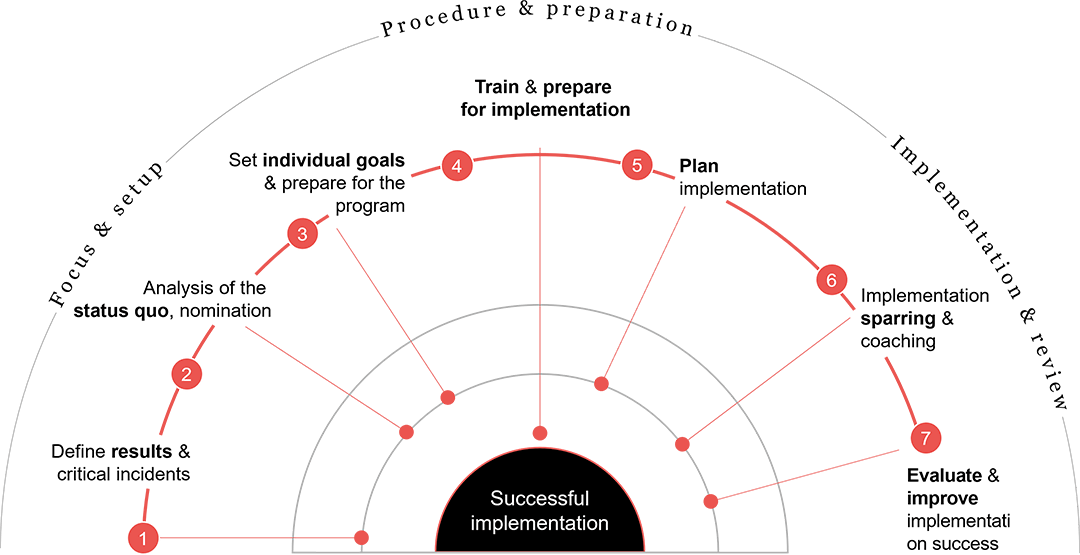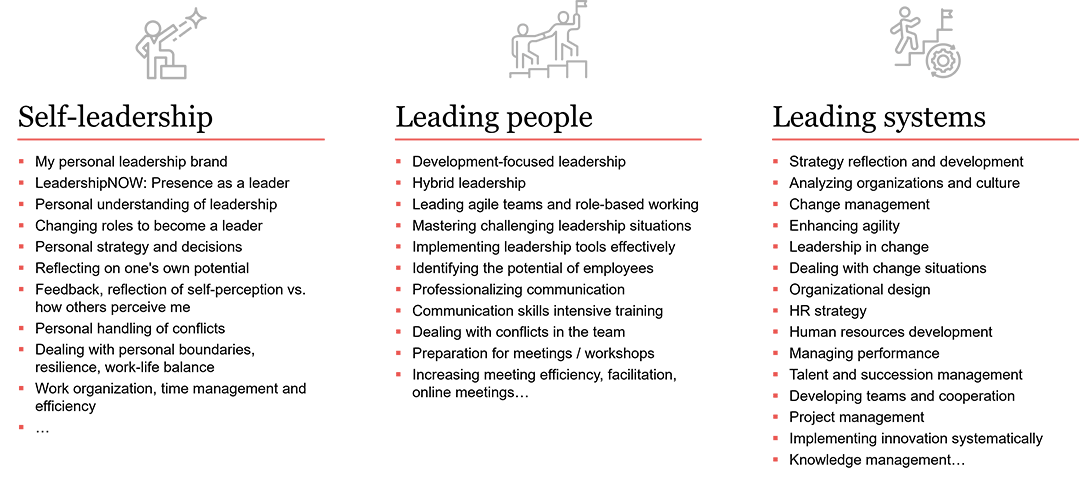Leadership Programs: Custom-made with Impact
- What makes leadership particularly valuable for your organisation?
- What unites leaders in behavior and interaction?
- How well do your leaders deliver on the promises of your employer brand?
An effective leadership program encourages leaders to have a positive encounter with themselves: It is all about curiosity and honest interest in personal strengths, potential and areas for development, and last but not least, in their own blind spots. To discover these one step at a time and to find a conscious attitude towards their own leadership role is the bedrock for effective self-management and credible, sustainable leadership even when faced with challenging leadership situations.
Based on their own leadership purpose “Why am I in this role, what is the purpose of my work as a leader?” the participants shed light on their Circle of Influence: through reflective analysis of responsibilities, requirements of their role, leadership tools and methods that are appropriate for the organisation and their personality.
Successful Implementation
Any given program is only as good as its effect on the everyday life of its participants and their environment. This is why we work with specific cases and assignments from the participants' day-to-day work, with a strong focus on implementation, and on planning the transfer. Leadership programs deliver their maximum impact when the participants, their managers and HR focus on and reinforce the implementation of the program in their daily leadership practice - before, between and after the training sessions.

Abb.: Focus on Implementation
Phase 1: Focus & Setup
Step 1: Define results & Critical Incidents
In the first phase of the leadership program, clear outcomes and critical incidents are identified that can significantly impact the program's success. This definition lays the foundation for all subsequent steps and ensures that the program's goals are clear and measurable.
Step 2: Analysis of the status quo, nomination
An assessment is conducted to analyze the current status of the participants and the organization. Subsequently, the leaders who will participate in the program are nominated. Careful selection is crucial to identify the right individuals for the development and implementation of the program.
Step 3: Set Individual Goals & Prepare for the Program
Specific, measurable, achievable, relevant, and time-bound (SMART) goals are set for the participants. Additionally, comprehensive preparation for the leadership program is carried out, including the provision of necessary information and resources. Clear goal setting and thorough preparation are essential to meet expectations and ensure the program's success.
Phase 2: Procedure & Preparation
Step 4: Train & Prepare for Implementation
In this phase, participants undergo targeted training to prepare for their leadership roles. These training sessions are designed to develop the necessary leadership skills and competencies required for effective implementation. Thorough preparation through training is crucial to ensure that participants are capable of successfully fulfilling their new roles.
Step 5: Plan Implementation
A detailed plan for implementing the leadership program is developed. This plan includes defining tasks, responsibilities, timelines, and resources. Thorough planning is critical to ensure a clear and structured process and to lay the groundwork for successful implementation.
Phase 3: Implementation & Review
Step 6: Implementation Sparring & Coaching
During the implementation of the program, continuous support is provided through implementation sparring and coaching. This phase includes reflecting on progress, addressing challenges, and adapting to changing conditions. Ongoing support through coaching is essential to help leaders apply their new skills effectively and assert themselves in their roles.
Step 7: Evaluate & Improve Implementation Success
Finally, the success of the leadership program is evaluated. It is assessed whether the set goals have been achieved and what results have been obtained. This evaluation helps measure the program's success and provides valuable insights for future initiatives. Additionally, measures are taken to reinforce positive outcomes and ensure the sustainability of the achieved successes.
The success of the leadership program depends crucially on how well these phases and steps are executed. Each step contributes to developing the participants' leadership skills and promoting the organization's success.
Procedure & essential elements
1. Goals, leadership brand and leadership competencies as the foundation
The goals of your organisation, your leadership brand, your leadership principles, competencies, and tools form the basis and the starting point for the conception of your leadership program - or we can continue to develop these together to meet changing requirements. Building on this, we work together to design a coherent leadership development strategy with long-term development goals.
2. Determining the status quo
By determining the current status quo - based on (future) success-relevant competencies and situations - we enable participants to engage with their current perception of their role, making it “visible”, “understandable”, and consequently actionable. The overall outcome offers an inventory of strengths and areas for development both individually for all participants and in an overview for the respective target group or, across several sessions, an overview of the “leadership landscape” in the organisation. Leadership standards that are currently lived (and experienced by the employees) become visible. The individual profile identifies clear strengths, potential and areas for development, which can then be addressed by the individual participants with a recommended course of development in the context of the leadership program.
3. Concept
The currently applicable leadership program is designed based on the results of assessing the status quo, ideally in co-creation with HR and with feedback from the participants and equipped with results that can be evaluated. The content and format are tailor-made. We build on existing, successful formats that have already proved themselves in your organisation, adapt them or work with you to develop new formats in order to provide the best possible support for achieving the program's goals.
4. Plan for personal development
Every participant now has their own personal path of competence development in line with the leadership brand, which takes their individual aptitudes into account. Using their personal compass for developing their individual competencies, participants can make conscious and autonomous use of various program offerings in the form of training courses, projects, learning journeys, supporting coaching/sparring, and consulting. Deciding whether the sessions take place face-to-face with/without outdoor elements or whether they are virtual or hybrid, whether there is shadowing/mentoring near the job in addition to individual coaching are questions which are a relevant part of the conceptual work. Besides practicable solutions, there is also a focus on the specific development goals of the participants.
5. Training & Coaching
Leadership is achieved through communication – during training we make use of the group: Expressing oneself, receiving feedback, expanding knowledge, trying out new ideas, and mutually using and integrating feedback. In every session, everyone equally gives and receives feedback, while learning together is achieved in a safe and moderated setting.
Examples of training and coaching topics from leadership programs, which can be individually adapted and combined:

6. Evaluation
A key driver to firmly anchor any leadership program in an organisation is evaluation and the use of the insights that are gained from it for participants - individually but also for management and HR. In this respect, evaluation workshops with elements of a development center, 360° interviews, and the use of an employee survey with complementary focus groups have proven to be effective, ideally in combination with an evaluation team that also includes “hard facts” in the evaluation such as levels of target achievement, fluctuation numbers, and talent nominations.
